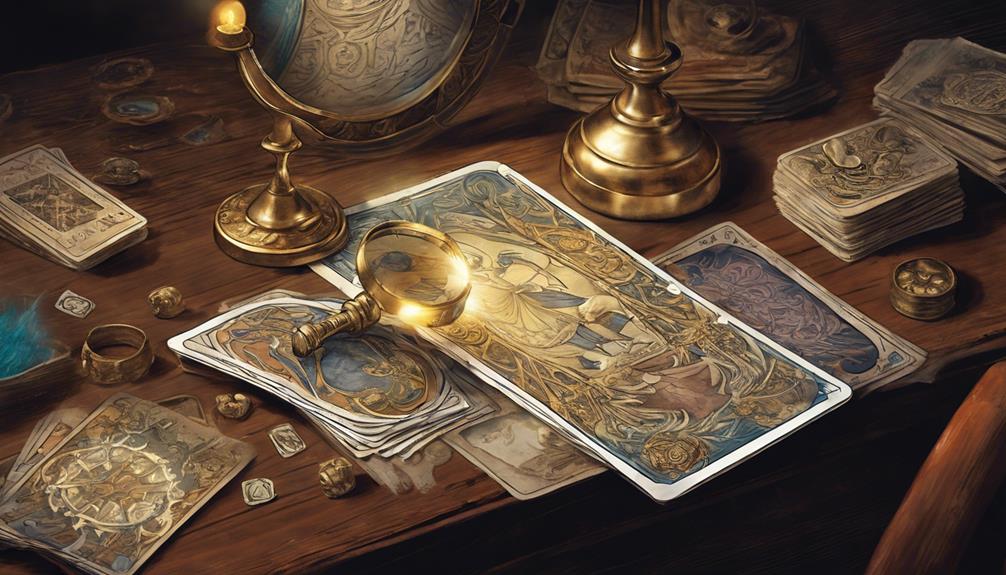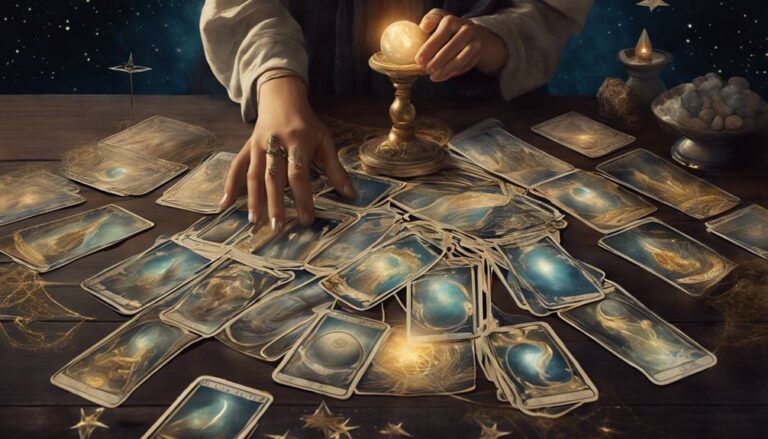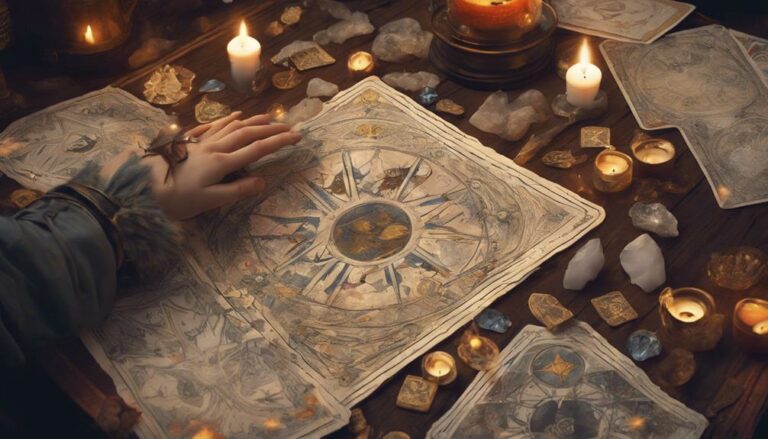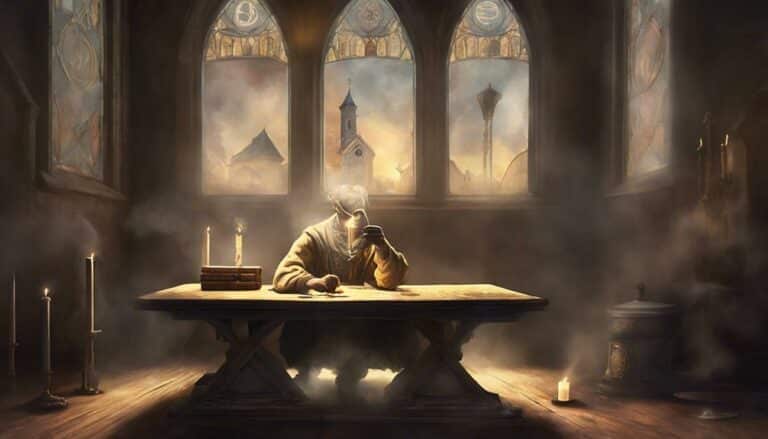Table of Contents
To discern if tarot cards bear substance or merely masquerade as mystical tools requires delving into their profound history, understanding the symbolic intricacies of the Major and Minor Arcana, and appreciating their role in self-reflection and personal growth. Tarot’s origins, evolving from a 15th-century game to a means of divination, underscore its enduring relevance. Mastery of tarot symbology and a recognition of its limitations in predicting the future emphasizes its true value: offering insight and guidance, not deterministic foresight. By recognizing common misconceptions and the ethical use of tarot, one approaches a deeper appreciation of its potential for personal empowerment. Through exploring these dimensions, one gains a holistic perspective on tarot’s legitimacy.
Key Takeaways
- Evaluate the depth of symbolism and interpretive methods used in readings for their alignment with universal human experiences.
- Understand that tarot cards are tools for reflection and guidance, not definitive predictors of the future.
- Recognize the importance of the reader’s intuition and knowledge in providing meaningful insights, rather than relying solely on the cards.
- Research the historical evolution of tarot from gaming to spiritual guidance to appreciate its cultural and symbolic significance.
- Be wary of readings that claim absolute certainty or that exploit personal fears and uncertainties.
Understanding Tarot Basics
Exploring the domain of tarot requires a fundamental understanding of its two primary components: the Major and Minor Arcana, which are essential for interpreting the profound messages and guidance these cards offer. The Major Arcana cards, emblematic of significant life events and spiritual lessons, serve as the foundation for those seeking to wield the power of tarot with precision and depth. Each card within the Major Arcana encapsulates a universe of symbolism, offering a mirror to the soul‘s journey through the vicissitudes of existence.
To master this domain, one must probe beyond superficial interpretations, engaging with the cards in a dialogue that transcends the mundane. The Major Arcana cards do not simply predict; they illuminate paths, revealing the intricate web of cause and effect that weaves through our lives. For the adept, these cards become a tool of transformation, enabling one to navigate the complexities of life with foresight and wisdom. Understanding the structure and significance of these cards is not just an intellectual exercise but a profound spiritual engagement, offering insights that can guide one towards personal empowerment and enlightenment.
Decoding Tarot Symbolism
As we delve into the intricate world of Decoding Tarot Symbolism, it is crucial to acknowledge the profound depth that understanding tarot archetypes, revealing symbol meanings, and interpreting color significance can bring to the art of tarot reading.
This exploration not only enhances the richness of insights gleaned from each card but also nurtures a more nuanced connection between the reader and the mystical tapestry woven by the tarot deck.
Setting off on this journey promises to illuminate the multifaceted layers of symbolism, inviting both experienced practitioners and novices alike to engage with the cards in a way that transcends mere surface-level interpretation, thereby revealing a more profound, personalized understanding of the messages they hold.
Understanding Tarot Archetypes
Delving into the world of tarot, one encounters a rich tapestry of archetypes that serve as universal symbols reflecting the myriad facets of human experience. These archetypes, ranging from the Fool to the Hierophant, embody the essence of our collective unconscious, offering a framework to explore the psychological, spiritual, and emotional dimensions of life.
By understanding the archetypal energies and their influences on readings, one taps into a deep well of wisdom. Decoding these symbols is not merely an intellectual exercise but a journey into the soul, where good advice and the mandate to trust your intuition emerge as guiding principles.
Engaging with tarot archetypes thus becomes an introspective endeavor, revealing insights that resonate on a profoundly personal level.
Symbol Meanings Unveiled
Building on our understanding of tarot archetypes, we now turn our attention to the rich symbolism woven into each card, which opens new dimensions of interpretation and insight.
Tarot symbols, embodying deep meanings and potent energies, act as conduits to the overarching message each card endeavors to communicate. These symbols, ranging from universally recognized motifs to those unique to specific decks, encapsulate various facets of human experience, offering a kaleidoscope of perspectives for the adept interpreter.
Engaging with tarot symbolism not only enriches the tapestry of a reading but also empowers the interpreter with a more nuanced comprehension, thereby enhancing the potential for profound insights. Delving into this symbolism enhances the interpretive power, transforming the tarot from mere cards to a mirror reflecting the complexities of life and the human psyche.
Interpreting Color Significance
Peeling back the layers of tarot symbolism reveals a vibrant spectrum of colors, each carrying its own unique significance and contributing to the depth of interpretation in a reading. In the domain of tarot cards, color symbolism is not merely aesthetic but a profound language speaking directly to our subconscious.
Red’s bold vibrancy invokes notions of passion, power, and the primal energy driving our deepest desires. Blue, in its serene majesty, embodies communication, intuition, and spirituality, offering a soothing counterpoint to red’s intensity. Green weaves a narrative of growth, abundance, and healing, echoing the natural world’s boundless capacity for renewal.
Yellow, with its luminous glow, heralds joy, intellect, and a positive outlook, illuminating the path toward enlightenment. Each hue in tarot cards is a thread in the tapestry of our psyche, a guide towards understanding the complex interplay of forces shaping our lives.
The History of Tarot Cards
Tarot cards, initially developed in the 1400s for recreational gaming, gradually evolved into a profound tool for divination and spiritual introspection. This remarkable transformation from mere playing instruments to venerable symbols of esoteric wisdom underscores a rich history, laden with metaphysical undertakings and the human quest for understanding the unseen. The inception of tarot decks as gaming tools belies their eventual stature as eminent conveyors of the arcane. It wasn’t until the emergence of cartomancy in 1785 that these cards transcended their mundane origins, becoming revered mediums through which the veil between the known and the unknown could be penetrated.
The late 1800s heralded a pivotal era, with the Hermetic Order of the Golden Dawn instrumental in redefining tarot cards‘ purpose and significance. This period saw the birth of notable tarot decks, including the Rider-Waite and the Thoth decks, which further entrenched tarot’s place in the annals of mysticism. Each card, especially those within the Minor Arcana, began to embody specific symbols and meanings, offering a nuanced language for seekers of wisdom. This evolution from playful pastime to a powerful tool for spiritual guidance and self-reflection epitomizes the tarot’s enduring allure and its capacity to illuminate the path of introspection for those who dare to explore.
Common Misconceptions Addressed
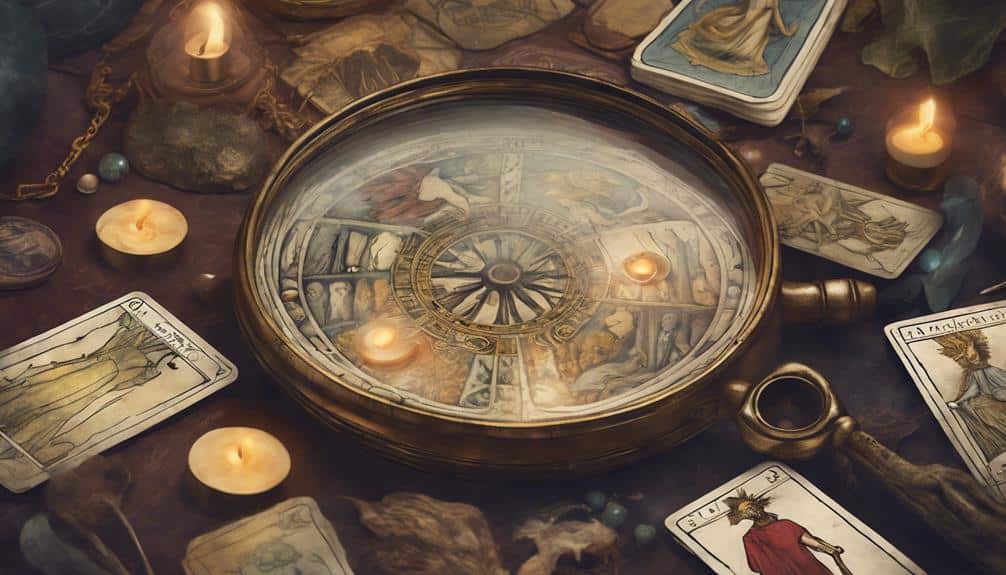
As we shift from the rich historical tapestry of tarot into addressing prevalent misconceptions, it becomes crucial to explore the nuanced complexities surrounding the interpretative and predictive dimensions of tarot cards.
The common misunderstandings regarding their symbolic meanings and the boundaries of their predictive power not only obscure the true essence of tarot but also hinder individuals from harnessing its profound potential for introspection and personal evolution.
Misreading Symbolic Meanings
A common pitfall in the practice of tarot reading is the misinterpretation of its richly symbolic imagery, which can greatly skew the accuracy of a reading. The essence of tarot cards lies within their symbolic meanings, each emblem and figure intricately woven into the fabric of divination, holding profound significance.
Misunderstanding these symbols, one might inadvertently project their biases or misconceptions, leading to readings that diverge from the intended messages. Mastery in tarot necessitates a deep, reflective study of the symbolic meanings, an endeavor that not only enhances the precision of readings but also enriches the reader’s connection to the ancient art.
Recognizing the depth of each symbol is paramount, allowing for interpretations that resonate with clarity and insight.
Predictive Power Limits
Understanding the boundaries of what tarot readings can realistically offer is essential in appreciating their value as a tool for reflection and guidance.
Tarot cards illuminate the terrain of our lives, offering insights and potential paths, rather than dictating a fixed future. This is a critical distinction for those who seek to wield power over their destinies.
The future, a tapestry woven from the threads of countless decisions and variables, eludes the certainty of prediction. Acknowledging the limits of tarot’s predictive power encourages a balanced perspective, recognizing that the cards reveal possibilities and guide us through the labyrinth of life’s uncertainties.
They serve not as a map of destiny, but as a compass for exploring the good and bad, empowering us to chart our course with wisdom and insight.
Interpreting ‘Negative’ Cards Positively
Interpreting ‘negative’ tarot cards in a positive light requires a deeper exploration beyond their initially intimidating appearances. Cards like the Devil and the Nine of Swords, often feared for their ostensibly ominous symbolism, are in fact repositories of profound wisdom and catalysts for personal empowerment. The Devil card, frequently misconstrued as a harbinger of malevolence, actually invites us to investigate our bindings and question the chains of dependence that inhibit our growth. It serves as a mirror reflecting our shadow selves, urging introspection and the reclaiming of personal power from the vestiges of self-imposed limitations.
Similarly, the Nine of Swords, with its portrayal of despair and anxiety, compels us to confront the darkest corners of our psyche. It is in this investigation that we are offered the opportunity for radical honesty with ourselves, catalyzing a journey towards mental resilience and emotional liberation. Embracing these cards with openness and a willingness to explore the discomfort they may herald allows us to unearth invaluable insights into our psyche. It is through this process of personal alchemy that ‘negative’ cards become conduits of profound self-reflection and monumental growth, challenging us to transcend our perceived limitations and evolve into our fullest potential.
The Role of Intuition in Readings

Intuition, a pivotal element in tarot readings, greatly influences the depth and accuracy of personal insights and interpretations. This innate power, when harnessed, serves as a guiding force, enhancing the symbiotic relationship between the reader and the cards. It is through trusting one’s instincts that the layers beneath the imagery and symbols begin to reveal, exposing messages that are both profound and pertinent.
The act of interpreting tarot cards is not merely an exercise in rote memorization but an intimate dance with intuition. This internal compass directs the reader toward subconscious knowledge and spiritual guidance, allowing for a reading that resonates on a deeply personal level. It is this intuitive connection that can expose hidden meanings, offering insights that transcend the superficial.
Moreover, the development and refinement of intuitive abilities are paramount in discerning the authenticity and relevance of each reading. Therefore, intuition is not just a component of tarot readings; it is their very essence. It empowers the reader, providing a tool of unparalleled power in the quest for understanding and enlightenment. Through intuition, the tarot becomes a mirror, reflecting not just possibilities, but the depths of the soul.
Tarot Vs. Scientific Evidence
As we shift from the domain of intuition to the scrutiny of scientific evidence, it becomes crucial to explore the nuanced relationship between tarot practices and the empirical scientific method.
The variability inherent in tarot interpretations stands in stark contrast to the rigidity of scientific validation, illuminating the gap between personalized spiritual experiences and universally accepted scientific principles.
This juxtaposition invites a contemplative examination of the scarcity of empirical evidence supporting tarot, urging us to question the boundaries of knowledge and the myriad ways in which truth can be discerned.
Scientific Method Limitations
In examining the contrast between tarot readings and scientific evidence, it becomes evident that the scientific method’s reliance on empirical data and reproducibility presents limitations when applied to the intuitive and symbolic nature of tarot cards.
The rigorous frameworks of science, designed to yield quantifiable and universally applicable outcomes, starkly differ from the nuanced domains of intuition and symbolism that tarot cards inhabit. This disparity underscores a fundamental divide: the measurable and observable phenomena championed by science versus the deeply personal and subjective insights offered through tarot.
Acknowledging this distinction does not diminish the value of either approach but rather illuminates the unique contributions they make to our understanding of reality, encouraging a harmonious coexistence that respects the strengths and addresses the limitations inherent in each.
Tarot Interpretation Variability
Acknowledging the inherent differences between the scientific method and tarot readings illuminates the significant variability in tarot interpretation, which is deeply rooted in subjective experiences and personal symbolism. This variability emerges from the intricate tapestry of meanings attributed to each card, meanings that are not static but evolve with the reader’s perspective and the cultural context.
Unlike the rigid frameworks sought by science, tarot interpretation thrives on fluidity, drawing on intuition and the rich symbolism embedded within the cards. It eschews empirical validation, instead offering a labyrinthine path towards personal insight and spiritual guidance.
The power of tarot lies not in objective truth but in the subjective domain of personal interpretation, making each reading a unique confluence of card meanings and individual experience.
Empirical Evidence Shortage
Despite widespread interest and practice, there is a notable lack of empirical evidence supporting the predictive capabilities or accuracy of tarot readings.
- Scientific evidence does not validate tarot’s predictive powers.
- Readings rely on intuition and personal interpretation, not empirical data.
- Skepticism arises from the absence of empirical support.
- Tarot is considered pseudoscience due to the lack of verifiable evidence.
- Accuracy and effectiveness of tarot readings are subjective, not empirically validated.
For those who seek power through knowledge, understanding the empirical evidence shortage in tarot readings illuminates the chasm between belief and verifiable truth, urging a reevaluation of reliance on such methods for decision-making and insight.
Ethical Considerations in Tarot
Ethical considerations play a pivotal role in ensuring the integrity of tarot readings, emphasizing the importance of confidentiality, informed consent, and professionalism. For tarot readers, these ethical considerations form the foundation of trust and respect between them and their clientele. It is imperative upon these practitioners to navigate the delicate balance of empowering clients while maintaining a boundary that respects their autonomy and decision-making capabilities. The act of seeking guidance from the tarot demands a space where privacy is sacrosanct, and the confidentiality of client disclosures is preserved with the utmost seriousness.
Further, the ethical compass of tarot readers mandates a steadfast commitment to non-exploitation. This entails delivering readings with a core of compassion and non-judgment, ensuring that the power dynamics inherent in such interactions are navigated with integrity and sensitivity. By eschewing the temptation to provide advice in domains outside their purview—such as medical, legal, or financial matters—tarot readers uphold a standard of professionalism that not only respects the limitations of their craft but also honors the trust placed in them by those they serve. In this way, ethical considerations in tarot not only safeguard the practice but elevate it to a sphere of profound respect and dignity.
Finding a Reputable Tarot Reader
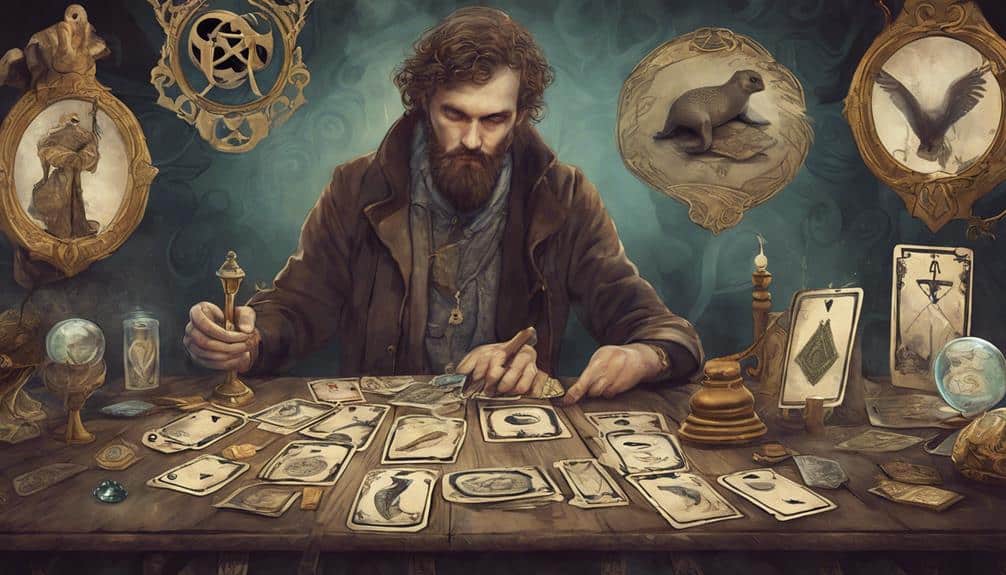
In the quest for genuine guidance, selecting a reputable tarot reader is of paramount importance. As you navigate the world of tarot, the credibility of your guide is a non-negotiable pillar that will determine the value and integrity of the insights received.
To empower your journey and guarantee a connection with a tarot reader of the highest caliber, consider the following criteria:
- Look for tarot readers with formal training and certification to guarantee credibility.
- Seek recommendations and reviews from previous clients to gauge the reader’s reputation.
- Avoid tarot readers offering unrealistically cheap or too-good-to-be-true services.
- Reputable tarot readers often have a clear communication style and ethical practices.
- Consider the reader’s experience, expertise, and specialization in specific areas of tarot interpretation.
These guidelines serve as your compass in the vast sea of tarot readers, leading you to individuals whose presence resonates with professionalism and authenticity. By prioritizing these characteristics, you align yourself with practitioners who not only respect the ancient art of tarot but also honor the personal journey of every querent seeking wisdom through their cards.
Embracing Tarot for Personal Growth
Tarot cards serve as a powerful medium for personal growth, offering insights that encourage introspection and self-improvement. By interpreting cards through a lens of positivity and reflecting on entrenched beliefs, individuals begin on a journey towards profound personal transformation. Embracing tarot for personal growth is not merely about seeking answers but about utilizing these mystical tools as catalysts for healing emotional wounds and fostering evolution within oneself.
Viewing tarot readings as gateways to self-discovery allows individuals to explore into the multifaceted aspects of the human experience, unearthing wisdom that lies dormant. Trusting in the guidance and insights provided by the cards empowers seekers to face life’s challenges with newfound clarity and resilience. It is this trust that transforms a simple tarot reading into a beacon of empowerment, illuminating paths previously shrouded in uncertainty.
To fully embrace tarot for personal growth, one must shift their perspective to perceive every card drawn as a lesson imbued with opportunities for growth. This approach not only demystifies the practice but also elevates it to a tool for profound personal development, aligning with the aspirational desires for power and mastery over one’s destiny.
Frequently Asked Questions
When Should You Not Read Tarot Cards?
One should not read tarot cards when ethical boundaries or personal crises are at play, including during emotional instability, without consent, under substance influence, as a sole decision-making tool, or as a substitute for professional advice.
Do Tarot Cards Come With a Guide Book?
Yes, many tarot cards are accompanied by guidebooks, offering insights into card symbolism and reading ethics, furnishing users with the knowledge necessary to harness the power within for profound personal and spiritual growth.
Is There a Right Way to Read Tarot Cards?
The proper way to read tarot cards combines a profound understanding of card symbolism with adherence to reading ethics, empowering users to discover insights while respecting the interpretative nature of the practice.
Should You Knock on Your Tarot Cards?
Whether one should engage in knocking on tarot cards as a form of card cleansing is a matter of personal rituals. This practice can greatly enhance the reader’s focus and connection with the deck.
Conclusion
In wrapping up, the analysis of tarot cards through a multifaceted perspective encompasses their historical origins, symbolic complexities, and the moral dimensions that shape their use. This invites a nuanced comprehension that goes beyond dismissive skepticism or uncritical acceptance.
This investigation promotes a discerning interaction with tarot, presenting it not as a definitive oracle but as a tool for introspection and personal growth. It encourages individuals to navigate the domains of the metaphysical with an informed, critical, and open-minded approach, thereby enriching their journey towards self-discovery and understanding.

